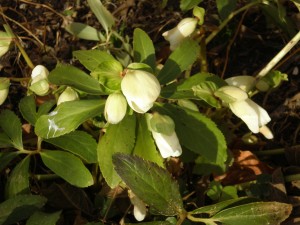March & April: Spring in the Yard
by Janet Woody, Librarian, Lewis Ginter Botanical Garden
The best time of year is upon us, when warm temperatures encourage new growth that we can almost watch happening. Miraculously, trees and shrubs are forming new buds, perennials are breaking through, hellebores and showing off bright new flowers. It’s a miracle! And a great time to get outside and enjoy the fresh air.
A few things you might want to do while you are out there:
–Finish cleaning up any remaining dead plant materials. The birds are done with them now, having gleaned all of the seeds and taken shelter under them during bitter weather.
–Clean under and inside of shrubs that tend to be leaf-catchers before the plant makes its new leaves.
–Remove all leaf matter from under photinias, as rotting leaf materials encourage leaf spot (the fungus Entomosporium maculatum), a major killer of photinia. These plants like a lot of air circulation, so keep them clean and branched-up trimmed at the bottom of the shrub. Avoid mulch at the base of the plant.
–If you haven’t pruned roses and butterfly bushes, now is the time.
–Chaste tree (vitex agnus-castus) has become quite popular in our area. These look similar to butterfly bushes with a long purple bloom in the summer. This bloom is upright, where butterfly bush blooms arch gracefully. Did you know you should prune your chaste tree the same way you prune butterfly bush? Yes, you should, and now is the time to do it.
Got Grubs? If you had a significant Japanese beetle population last summer, you may want to check your soil for evidence of grubs. You can assess your grub problem by digging up a square foot of soil (keeping the soil in a block) and turning it over so you can see how many grubs are likely to be growing down there. If you see no or a few grubs, no special treatment is needed. Skeletonized leaves and brown patches in the lawn are signs of beetle and grub damage.
The University of Kentucky College of Agriculture has a great article on Japanese beetles that includes a grub growth chart, list of plants affected, and control information: While the control information may be particular to Kentucky, all of the information given applies to Virginia also.
–Fertilize acid loving plants with Holly-Tone 4-6-4 or similar product. Acid lovers include azaleas, rhododendron, camellias, hollies, hydrangea, gardenia, and dogwood.
–Fertilize roses with Rose-Tone or 6-6-4 blend.
–Fertilize other plants with Plant-Tone 5-3-3 or Osmocote 14-14-14 slow release.
A note about fertilizers: this blog entry is not meant to be an endorsement for a particular brand of fertilizer, and is only meant to illustrate which plants like a particular blend of the primary nutrients nitrogen-phosphorus-potassium, the ingredients referred to in the numbers following a product name. For example, Rose-tone contains 6 percent nitrogen, 6 percent phosphorus, and 4 percent potassium per pound of fertilizer.
Annuals and vegetables: Planting dates for most annuals and vegetables is April 15 or the last average frost date. Some tender or especially heat-loving or heat needing plants should be planted later when the soil temperatures are appropriate. That’s plant-specific and seasonally dependent. If you need a blast of color now, pansies and violas love the cool weather and are unfazed by frosts and cold soil. If you don’t have hellebores, daffodils and crocus bulbs, plan now to plant these next fall so you’ll more have color this time of year.
*Information gleaned from the publication Month-to-Month Perennial and Shrub Maintenance Chart for the Mid-Atlantic Regions, prepared by the National Capital Area Garden Clubs, Inc. 2nd ed. 2008, in the ready reference collection in the Garden library.
